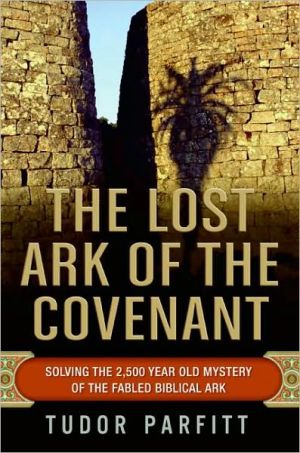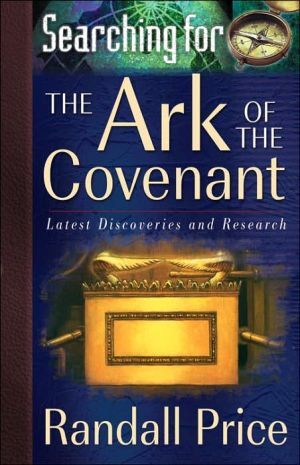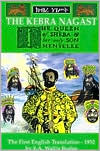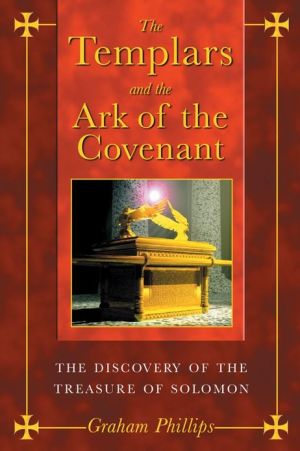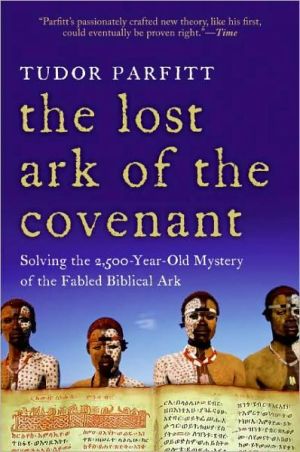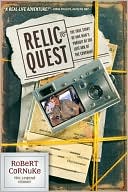Lost Ark of the Covenant: Solving the 2,500 Year Old Mystery of the Fabled Biblical Ark
The Lost Ark of the Covenant is the real-life account of an astounding quest—professor Tudor Parfitt's effort to recover the revered artifact that contained the Ten Commandments, sacred to Judaism, Christianity, and Islam.\ This holy object disappeared from the Temple when the Babylonians invaded Jerusalem in 586 BC and was lost—apparently forever.\ According to the biblical account, the Ark was built at the command of God, in accord with Moses's prophetic vision on Mount Sinai. The Ark,...
Search in google:
The Lost Ark of the Covenant is the real-life account of Professor Tudor Parfitt's effort to recover the revered artifact that contained the Ten Commandments sacred to Judaism, Christianity, and Islam. This holy object disappeared from the Temple in Jerusalem when the Babylonians invaded in 586 BCE and was lost—apparently forever.With painstaking historical scholarship, groundbreaking genetic science, and hair-raising fieldwork, Parfitt debunks the previous myths and reveals the shocking history of the Ark and its keepers. From Israel to Egypt, Ethiopia, and the ruins of Great Zimbabwe, the journey leads to places Parfitt could never have imagined.The Lost Ark of the Covenant is a vivid and page-turning account of the culmination of two decades of research by an acclaimed scholar and adventurer. In the end, legend becomes reality as an unknown history comes to light, and with it our understanding of this lost treasure is changed forever. The Times “Parfitt’s scholarly, fascinating work explains and explodes a pervasive myth.”
The Lost Ark of the Covenant\ Solving the 2,500-Year-Old Mystery of the Fabled Biblical Ark \ Chapter One\ The Cave\ It was a time of drought.\ In 1987 my home was a grass hut in a dried-out tribal area of central Zimbabwe in southern Africa, completely cut off from the outside world. I had been doing fieldwork on a mysterious African tribe called the Lemba. This was part of my job. At the time I was Lecturer in Hebrew in the Department of Near and Middle Eastern Studies at the School of Oriental and African Studies (SOAS) in the University of London and for a while now this tribe had been my main academic subject.\ How had I spent my time in the village? In the blistering heat of the day I would wander over the hills near the village and poke around the remains of the ancient stone-building culture, which, the Lemba claimed, was the work of their distant ancestors. With my little trowel I had discovered a few bones, pieces of local pottery, and one or two iron tools of uncertain age. Not much to write home about. Then I would read, write up my notes, and spend much of the night listening to the elders' narratives.\ The Lemba harbored an astonishing claim to be of Israelite origin, although the presence of Israelites or Jews in central Africa had never before been attested. On the other hand, since early medieval times there had been rumors of lost Jewish kingdoms in darkest Africa. What I had heard was that the tribe believed that when they left Israel they settled in a city called Senna—somewhere across the sea. No one had any idea where in the world this mysterious Senna was located and neither did I. The tribe hadasked me to find their lost city, and I had promised to try.\ What I knew about the 40,000-strong Lemba tribe in 1987 was that they were black, they spoke various Bantu languages such as Venda or Shona, they lived in various locations in South Africa and Zimbabwe, they were physically indistinguishable from their neighbors and that they had a host of customs and traditions identical to those of the African tribes among whom they lived.\ They appeared to be completely African.\ But, on the other hand, they also had some mysterious customs and legends that did not appear to be African. They did not intermarry with other tribes. They did not traditionally eat with other groups. They circumcised their boys. They practiced the ritual slaughter of animals, using a special knife; they refused to eat pigs and a number of other creatures; they sacrificed animals on high places like the ancient Israelites; and they followed many of the other laws of the Old Testament. The sighting of the new moon was of cardinal importance for them as it is for Jews. Their clan names looked as if they were derived from Arabic or Hebrew or some other Semitic language.\ During the months I had spent in the village trying to unveil their secrets, I never found the absolute proof—the smoking gun, demonstrating that their oral tradition, which linked them with ancient Israel, was true. I never found an inscription on stone, a fragment of a Hebrew prayer, an artifact from ancient Israel. Not even a coin or a shard of pottery.\ Before arriving in Zimbabwe I had spent a couple of months with the large Lemba communities in the neighboring country of South Africa. Here the leaders of the tribe had given me a good deal of information. I had hoped to build on this in Zimbabwe and asked the local Lemba chief to facilitate my research. Chief Mposi called a meeting of the elders of the Lemba clans and, tempted by my promise to try to find their lost city of Senna, they formally agreed to permit me to research their history.\ But subsequently they did not tell me nearly as much as I had hoped they would. They were tight-lipped about anything to do with their religious practices. It was only my willingness to sit around late into the night, until my whisky had loosened the old men's tongues, that had enabled me to hear something of their remarkable cult.\ The following day they would regret their nocturnal indiscretions and mutter that the clan elders shouldn't have authorized my research, that white men had no business meddling in their affairs, and that I should stop trying to penetrate the cloak of secrecy that veiled their religious rites.\ Others tried to frighten me into leaving by telling me lurid tales of what had happened to previous generations of researchers who had wandered too far down forbidden paths. One of them had been forcibly circumcised after daring to walk on Dumghe, the tribe's sacred mountain. Another had wandered too close to a sacred cave at the base of Dumghe, and had been stabbed with a traditional assegai and badly beaten. He had narrowly escaped with his life.\ As my hopes of finding the critical clue regarding their true identity began to die, so did the crops in the fields around the village. It had not rained at all for months. There was some thick muddy liquid at the bottom of the boreholes. Every morning the women brought water in rusty old oilcans balanced on their heads. When that was gone, there would be nothing left to drink. Except beer from the bottle shop, for people with money. And there weren't many of those.\ This morning, early, before the sun had risen, the chief had called for a rain ceremony. The chief's messenger had arrived just as the household was beginning to stir. The cooking fire was being blown into life and water was being heated for tea and the washing water, which was brought every morning to my hut by the daughter of my gentle host, Sevias. The messenger told Sevias that his presence would be required that evening. This was a last desperate throw of the dice.\ The Lost Ark of the Covenant\ Solving the 2,500-Year-Old Mystery of the Fabled Biblical Ark. Copyright © by Tudor Parfitt. Reprinted by permission of HarperCollins Publishers, Inc. All rights reserved. Available now wherever books are sold.
1 The Cave 12 The Sign of His Kinship 233 Protocols of the Priests 454 The City of the Dead 815 A Key to the Past 996 Opposites Are One 1217 The First Cataract 1498 Legends of the Queen of Sheba 1779 The Tomb of Hud the Prophet of God 19910 The Moses Gene 23311 The Fire of God 24712 The Sacred Fire Pot 27913 Watchdogs of the King 31314 The Dust of Its Hiding Place 335 Epilogue 367 Index 373
\ From Barnes & NobleMost serious Bible students know that Ark of the Covenant was the hallowed vessel that contained the stone tablets bearing the Ten Commandments, as well as other sacred objects. The Ark disappeared during the Babylonian Conquest of Israel in 586 B.C. and has never been found. However, rumors have continued to swirl about the fate of this sacred relic, reports linking it to locales in England, Ireland, Egypt, and Ethiopia. In this book, Tudor Parfitt, the author of The Lost Tribes of Israel and Journey to the Vanished City, follows the trail of the Ark to what he believes to be its current resting place. An Indiana Joneslike adventure with religious implications.\ \ \ \ \ Library JournalDeemed "the British Indiana Jones" by the Wall Street Journal, Parfitt is both scholar (Sch. of Oriental & African Studies, London) and adventurer (his African quest for Israel's "lost tribes" was profiled on 60 Minutes). This real-life account reads like a story one might hear in a bar: a gripping, self-aggrandizing yarn that one is never sure how fully to believe. Parfitt describes his plying of drunk native priests for the mysteries of their cult, occasionally strays into casual boasting of his "voluptuous, salsa-dancing Latin American girlfriend" who "made love like no other woman in the world," and displays cinematic flair à la All the President's Men with his mantra, "Follow the priests." Each stage of his quest is predicated on scant evidence and "could have been" logic but then culminates in a surprise ending that may fall flat for movie buffs but largely redeems Parfitt as a scholar, revealing that he has all along ultimately been aware of the "unorthodox" and conjectural nature of much of his account. Recommended.\ —Darby Orcutt\ \ \ \ Daily Mail"It’s worthy of a Spielberg epic: an intrepid British don’s 20-year mission to find the Lost Ark of the Covenant."\ \ \ \ \ Time Magazine"Parfitt’s passionately crafted new theory, like his first, could eventually be proven right…"\ \ \ \ \ The Times"Parfitt’s scholarly, fascinating work explains and explodes a pervasive myth."\ \
